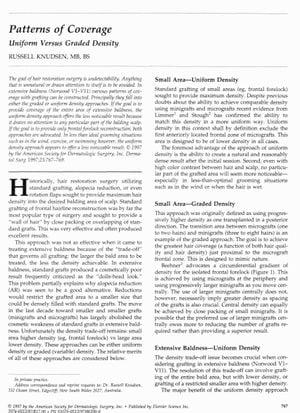Patterns of Coverage in Hair Restoration Surgery
September 1997
in “
Dermatologic Surgery
”

TLDR The article concludes that uniform density hair restoration is generally preferred for its natural look, but the best approach depends on the individual's characteristics and preferences.
In the 1997 article by Russell Knudsen, the author discusses the approaches to hair restoration surgery for extensive baldness, comparing uniform density and graded density techniques. The uniform density approach, which involves grafting the entire bald area with lower density, is favored for its less noticeable result, as it does not draw attention to any particular part of the scalp and maintains its naturalness even in less-than-ideal grooming situations. The graded density approach, on the other hand, aims to provide variable density across the scalp, with higher density in the frontal forelock area and thinner coverage in the crown, which can be more detectable in conditions like wind or water. Knudsen notes that while the dilemma of density trade-off remains, the shift to using minigrafts and micrografts has improved cosmetic outcomes in extensive baldness. The acceptability of either approach depends on the patient's desires, with factors such as hair-to-scalp color contrast, hair curl, patient age, and duration of baldness influencing the decision. Knudsen generally prefers the uniform density approach but emphasizes the importance of customizing the treatment plan to the patient's needs.





